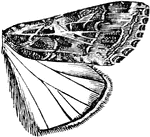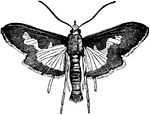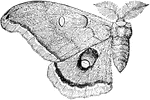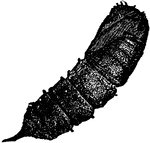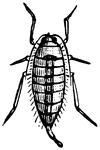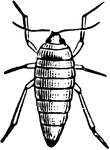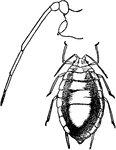!["The caterpillar of the [Lobster Moth] presents a strange appearance, though the moth has nothing remarkable about it."](https://etc.usf.edu/clipart/52700/52755/52755_lobster_larv_mth.gif)
Larva of Lobster Moth
"The caterpillar of the [Lobster Moth] presents a strange appearance, though the moth has nothing remarkable…

Luna Moth
"Among the larger and more splendid moths of our own country is the Luna Moth, or Green Emperor Moth,…

Leaf Blotch Miner Moth
"Gracilaria salicifoliella. GRACILARIA. In entomology, the typical genus of Gracilariidae, containing…
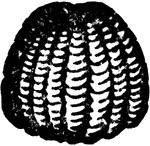
Owl Moth
The owl moth is a moth whose larvae are known to feed on a wide array of plants including a range of…

Owlet Moth
Wing of an owlet-moth, with all the markings defined and named.-Right wings: b, basal line; t.a., transverse…

Pickle Moth Larva
The larva of a Margaronia nitidalis on a small cucumber which had been eaten into.

Plum Moth
"Plum-moth (Grapholitha prunivora). GRAPHOLITHA. A genus of small and peculiarly marked tortricid moths,…
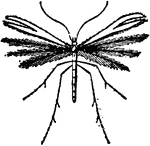
Plume Moth
"The insects of the group Pterophorina, are remarkable from the peculiar conformation of their wings.…

Plume Moth
"The insects of the group Pterophorina, are remarkable from the peculiar conformation of their wings.…
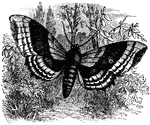
Larva of the Poplar Hawk Moth (Smerinthus Populi)
"The Poplar Hawk Moth lives on the poplar, the aspen, and sometimes on the willow and birch."

Larva of Privet Hawk Moth (Sphinx Ligustri)
"Of all the caterpillars of the genus Sphinx, this is the one which, by its attitude when in…

Pupa of Privet Hawk Moth (Sphinx Ligustri)
"Three of four days before it buries itself in the earth to change itself into a chrysalis, its colors…
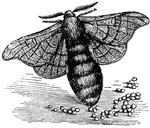
Silkworm Moth, Female (Bombyx Mori)
Females will take approximately three days to lay their eggs. When completed, they will have laid between…
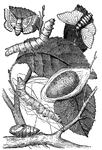
Larva, Pupa, Cocoon and Moth of Silkworm (Bombyx Mori)
The various stages of the Silkworm's life presented in a single diagram.
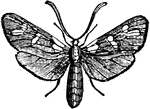
Six-Spot Burnet Moth (Zygaena Filipendulae)
It is also called the Ram Sphinx. "It is common from June to the beginning of August."

Sphinx Moth
"The Sphingina or Sphinx Moths, so callled from the curious havit which the larva have of raising the…

Sphinx Moth
"The Sphingina or Sphinx Moths, so callled from the curious havit which the larva have of raising the…
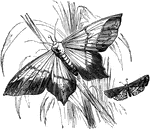
Swallow-Tailed Moth
The swallow-tailed moth (Ourapteryx sambucaria) and the many-plumed moth (Ourapteryx hexadactyla).
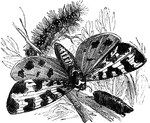
Tiger Moth
The garden tiger moth (Arctia caja) is named for the different and colorful patterns on its wings.

Garden Tiger Moth
The Garden Tiger Moth (Arctia caja) is a species of tiger moths that are also known by the synonym Euprepia…
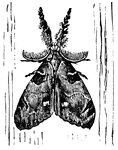
Tussock Moth
Tussock Moths, Lymantriidae or Liparidae, are a family of moths with about 350 known genera and over…

Vapourer Moth (Orgyia Antiqua)
"The Orgyias comprise a great number of small species, of a dark color, which do a great deal…

Wingless Moth (Female)
An illustration of a wingless female moth. Most species of moth are nocturnal, but there are crepuscular…
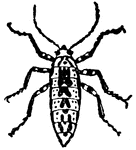
Winter Moth, Female (Hybernia Defoliaria)
"These creatures are found on many trees, but particularly n the oak, the foliage of which they often…

Winter Moth, Male (Hybernia Defoliaria)
"These creatures are found on many trees, but particularly n the oak, the foliage of which they often…
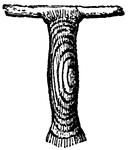
Case of Woolen Moth Attached to a Piece of Cloth
"When they are full grown, and the time approaches for their metamorphosis, they abandon their food,…
Larva of Woolen Moth Walking (Tinea Tapezella)
This caterpillar builds a case around itself using bits of cotton taken from clothing. If it does not…

Silkworm Moth, Caterpillar, and Chrysalis
"This important insect is a native of the north of China; and a great portion of the supplies of silk…

Milkweed Tiger Moth Larva
The larva Milkweed Tiger Moth (Euchaetes egle) is also known as the Milkweed Tussock caterpillar.

Milkweed Tiger Moth
The Milkweed Tiger Moth (Euchaetes egle) is an insect in the Arctiidae family of tiger moths.
